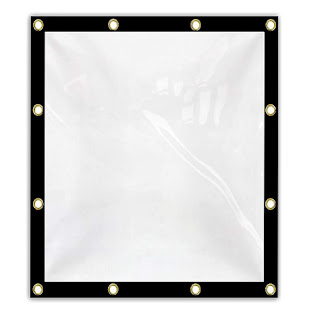Maintenance for Transparent Tarpaulins
Our transparent tarpaulins are composed of incredibly durable materials and are quite robust. These have strong construction and are robust. Whether you need to protect items outside or create a clearly covered space, these tarpaulins are an excellent solution for long-lasting quality and dependability.
Benefits of Transparent Tarpaulins:
These tarpaulins provide a variety of noteworthy benefits, beginning with their exceptional durability, which guarantees they survive harsh weather conditions and wear over time, giving dependable protection for your things. Because of their transparency, they enable natural light to enter while keeping rain and wind out, making them excellent for creating covered rooms that seem open and spacious. Because these are made of high-quality materials, they provide a reliable barrier against UV radiation, shielding them from fading and extending their lifespan. These tarpaulins are adaptable, cost-effective alternatives for preserving outdoor things, building up temporary shelters, or creating pleasant covered areas for a variety of activities.
Applications:
Outdoor event shelters
Greenhouses or plant covers
Patio or deck covers
Protective covers for vehicles or machinery
Temporary construction enclosures
Rain shields for outdoor markets or stalls
Clear walls for temporary structures
Pool covers
Windbreaks for camping or outdoor activities
DIY greenhouse or cold frame covers
Maintenance:
Maintaining tarpaulins is essential to ensure their longevity and optimal performance. Here are some maintenance tips:
Regular Cleaning: Using a soft cloth or sponge, gently wash the tarpaulins in water and mild soap. Avoid using anything abrasive that can scratch or harm the surface.
Avoid Using Harsh Chemicals: Harsh cleansers, solvents, and chemicals might damage the transparency and material quality.
Debris Removal: To avoid mold or stains, regularly remove leaves, dirt, and debris from the tarpaulin. You may accomplish this by gently shaking the tarp or using a soft brush.
Storage: Keep the tarpaulins out of direct sunlight and dry and clean when not in use. The tarpaulins' lifespan may be increased and wrinkles prevented by correctly rolling or folding them.
UV Protection: If the tarpaulins will be exposed to direct sunlight for a lengthy period of time, UV protectants or treatments should be used to avoid sun damage and discoloration.
Fix Tears Right Away: If you discover any tears or damage, fix them right away with transparent adhesive tape or tarpaulin patch kits. Ignoring minor difficulties might result in more serious issues.
Avoid Sharp Anything: Take care while placing or moving anything on or near the tarpaulins to avoid punctures or wounds.
Secure Fittings: If the tarpaulin is held in place by ropes, bungee cords, or clips, check to make sure they are securely fastened and are not creating unneeded stress points.
Examine Seams and Edges: Inspect the seams and edges for signs of wear or weakening on a regular basis. As necessary, strengthen or repair these sections.
Professional Inspection: For larger installations or tarpaulins used in critical applications, consider having periodic professional inspections to ensure they remain in top condition.



Comments
Post a Comment